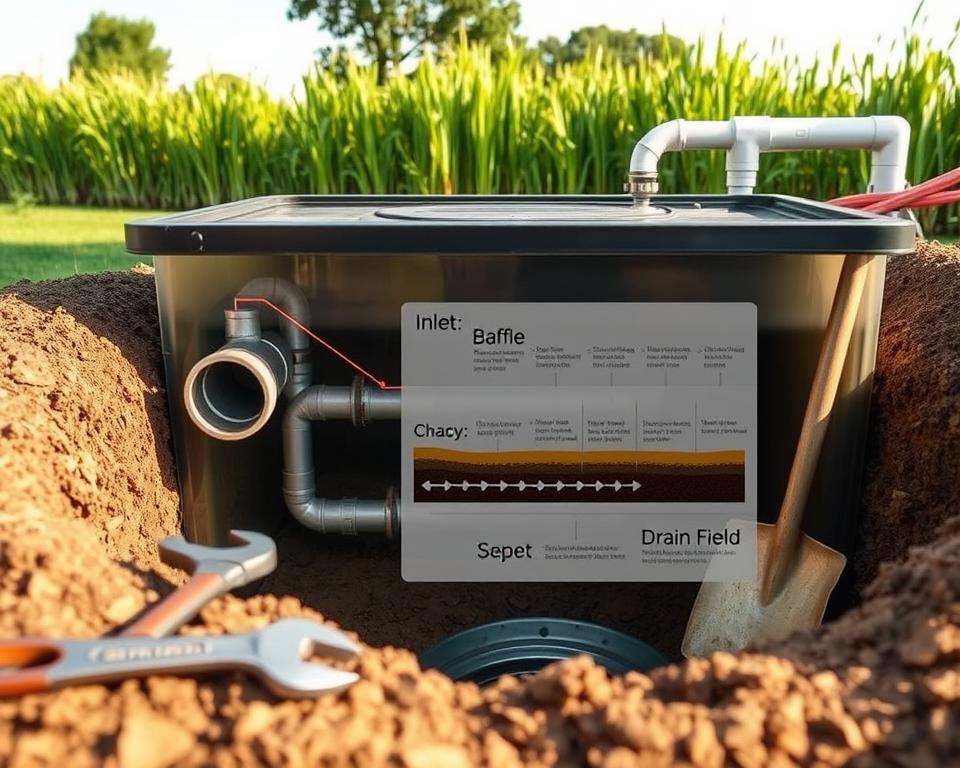Septic System Examination: Guarantee Your Security
Did you ever reflect on the value of your septic system and the risks of its failure? In modern times, where efficient sewage management is critical, septic system inspections are indispensable. They find issues in advance, warding off health risks and expensive repairs. Especially in rural locales, homeowners must make these assessments a priority for property safety and environmental cleanliness.
Major Insights
- Scheduled septic system inspections are vital for avoiding costly repairs.
- Septic tank assessment can identify problems early, protecting public health and ecosystem.
- A certified septic inspection entails thorough examinations by licensed inspectors.
- Understanding your septic system can boost its longevity and performance.
- Failing to inspect can lead to major health risks and property damage.
Comprehending the Importance of Septic Systems
Septic systems are integral for managing household wastewater, notably where there’s no municipal sewage link. They manage on-site wastewater treatment, holding harmful pollutants at bay. This procedure is vital for environmental safety.
Regular maintenance and checks are essential for septic systems to protect public health effectively. A system in good condition prevents wastewater leaks. These leaks can contaminate water sources, posing to drinking water and community health at risk.
There’s a direct link between a well-managed septic system and environmental protection. Effective operation of these systems is key to cutting pollution and fostering sustainable living with septic tank inspection.
What Happens During a Septic System Inspection
The septic system inspection involves key steps to verify its functionality and safety. Experts from All in Sanitation conduct a thorough review, focusing on several parts of the system. They strive to ensure everything is in excellent order.
During the inspection, technicians check the septic tank, looking for any leaks or pipe issues. They measure the septic tank’s liquid levels to guarantee optimal performance. This thorough evaluation prevents problems from escalating, sidestepping contamination and failure.
Understanding these key steps enables homeowners to manage their septic systems effectively. By spotting issues early through a proper inspection, the system’s life can be significantly extended. This safeguards against potential risks.
Key Parts Checked in a Septic System Inspection
A full septic system inspection examines key components to ensure its smooth functioning. The primary attention is on the septic tank, a key element of the system. Inspectors evaluate the tank’s condition, looking for wear or damage signs. They look over the tank walls, inlet and outlet pipes, and check for any blockages.
Inspectors also evaluate the drain field, essential for filtering effluent back into the groundwater. They look for standing water or unusual vegetation signaling issues. The distribution box’s flow and distribution are verified to confirm consistency across drain lines.
The septic baffle’s health is another critical check. Technicians ascertain that the baffles are intact and operate properly, stopping sludge from reaching the drain field. They also measure sludge and scum levels to ensure they are within safe limits.
The inspection’s closing phase is verifying the system’s watertight integrity. Inspectors confirm that the tank’s liquid level is normal, stopping any potential leaks or overflows. This comprehensive check helps spot minor problems before they become major repairs, thus safeguarding the septic system’s health.
| Component | Focus of Inspection | Role |
|---|---|---|
| Septic Tank | Condition of walls, pipes, and obstructions | Critical for waste collection |
| Drain Field | Standing water, vegetation anomalies | Ensures proper effluent filtration |
| Distribution Box | Flow and distribution checks | Maintains balanced drainage |
| Baffles | Integrity and function | Prevents sludge migration |
| Liquid Level | Verification of normal range | Prevents leaks and contamination |
Frequent Troubles Detected in a Septic System Inspection
In septic system inspections, experts often spot numerous problems that hurt system efficiency. Foremost are overloaded tanks, usually because of too much water use or unnoticed leaks. This condition prevents the system from processing wastewater correctly, resulting in backups and further issues.
Damage or malfunction in pipes is another usual issue found. Such faults block wastewater flow and can lead to expensive fixes if neglected. Blocked filters also pose major problems, diminishing system performance and creating environmental risks.
Poor maintenance worsens these septic problems. Through scheduled checks, such issues can be spotted and fixed early. This proactive approach saves homeowners from hefty repair costs and protects community health.
Duration of a Septic System Inspection
A standard septic inspection lasts from two to four hours. Factors like property size and septic complexity impact this duration. Should unanticipated problems arise or bad weather restrict access, inspection times may lengthen. Preparing in advance with these timeframes in mind enables homeowners to arrange smartly for a detailed check.
It’s wise for homeowners to observe the inspection. It gives them to ask questions and grasp the inspector’s observations firsthand. Setting this up for a time when full attention can be given improves the experience and final result.
| Factor Affecting Time | Time Range |
|---|---|
| Basic inspection | 2 – 3 |
| Complex system | 3 – 4 |
| Unforeseen issues | 4+ |
Frequency of Septic System Inspections
Routine septic inspections are key to maintain your system’s longevity and performance. It’s widely recommended for homeowners to have their septic system inspected every 3 years. This frequency may be modified depending on factors like the size of your household, the volume of daily water use, and the system’s age.
Bigger households or homes equipped with garbage disposals might need inspections sooner. Keeping up with the right maintenance schedule is important. It assists detect potential problems early and guarantees your system operates efficiently.
Here’s a helpful table outlining factors that might affect your inspection frequency:
| Factor | Inspection Cadence |
|---|---|
| Standard Household (2-3 people) | Every 3 years |
| Larger Household (4+ people) | Every 1-2 years |
| Home with Garbage Disposal | Every 1-2 years |
| Older Septic System | Annually |
Adhering to a consistent septic maintenance plan delivers peace of mind. It prevents expensive repairs and keeps your household safe and sanitary.
Results of Ignoring Regular Septic System Inspections
Not scheduling routine septic inspections increases the risk of system failures. Initially minor issues can grow into larger ones, necessitating expensive repairs. Wastewater backups from these failures jeopardize homes and the environment, risking groundwater contamination.
Unresolved septic issues subject people and pets to harmful bacteria and diseases. Homeowners could avoid hefty expenses with scheduled inspections. Ignoring routine maintenance can inflate a small problem into a larger crisis, upsetting your daily life and causing stress.
The financial burden of replacing an entire septic system can be crushing. Homeowners carry the full cost. However, ongoing inspections enable early problem detection, stopping issues from worsening. Consistent upkeep not only lengthens the system’s life but also spares homeowners from potential financial and environmental disasters.
Homeowner Tips: Maintaining Your Septic System
For homeowners, septic system care is critical for its longevity and function. Following proper maintenance tips guarantees smooth operation and reduces repair costs. Simple steps can greatly improve septic tank performance.
Water conservation in the home is crucial. Small changes like fixing drips and choosing water-saving fixtures ease strain on the system. Households should be aware of their water consumption.
Appropriate trash disposal is essential. Do not flush items such as wipes, period products, and grease – they damage the system’s balance. Dispose of such materials properly, using rubbish bins or compost.
Limiting strong chemicals is also vital. Household cleaners can kill the beneficial bacteria in your septic tank. Opt for eco-friendly cleaning products to protect this crucial ecosystem.
Ongoing monitoring on the drain field area are necessary for proper functioning. Watch for saturated soil or standing water, signs of possible problems. These issues require quick action.
| Action | Rationale |
|---|---|
| Conserve water | Prevents system overload |
| Properly dispose of waste | Maintains balance of the tank |
| Limit harsh chemicals | Protects beneficial bacteria |
| Inspect drain field | Identifies potential problems early |
Implementing these septic system maintenance strategies will keep your septic care at its best. This guarantees a functional, enduring system for the future.
Expert Septic Inspection Services
Engaging professional septic inspection services is important for homeowners. Companies like All in Sanitation offer detailed septic system evaluations. Their skilled experts ensure no major issue goes unnoticed.
These professional septic inspectors employ state-of-the-art methods to detect problems. This capability is key for ensuring your septic system’s longevity and your property’s health. They offer guidance on how to keep your system functioning well.
Benefits of Working with a Certified Septic Inspector
Working with a certified septic inspector brings key benefits for homeowners. These inspectors have thorough knowledge of local regulations and industry norms. Their expertise ensures thorough, accurate inspections, minimizing the risk of missing key issues.
These experts have the skills to detect a larger spectrum of potential issues. Thanks to their advanced training, certified inspectors can detect subtle signs of deterioration or failure. This ability guarantees problems are handled early, saving homeowners significant costs and preventing severe problems later.
Another important benefit is the peace of mind they provide to homeowners. Knowing a qualified professional is evaluating their system creates confidence. This confidence about the inspection’s quality offers added reassurance, supporting the system’s reliability.
In closing, the positives of engaging a certified expert for septic inspection obviously surpass any associated costs. These benefits include pinpoint accuracy, early detection of potential problems, and a strong sense of security among homeowners about their septic systems.
In Summary
Routine septic inspections are essential for homeowners who wish to avoid hefty repairs. These checks go beyond mere routine. They emphasize the vital importance of maintenance in keeping septic systems functioning smoothly.
Working with certified experts, such as All in Sanitation, allows homeowners to maintain the effectiveness of their septic systems. This forward-thinking strategy does more than just defend property value. It also bolsters community well-being and environmental health.
Taking timely measures on septic inspections protects your investment. It guarantees your home remains a protected and comfortable haven for your loved ones.



